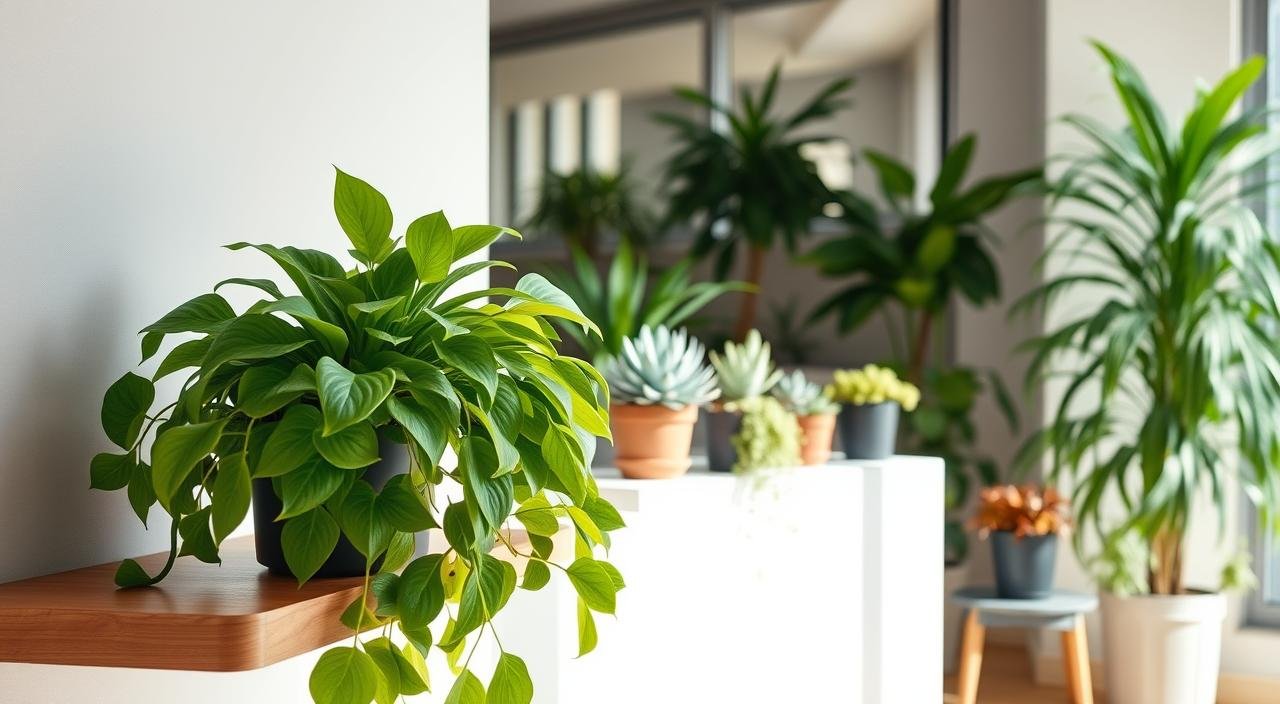Over 47% of indoor plants are pet-friendly, offering safe choices for homes with animals. Air quality in bedrooms can worsen overnight, but peace lilies boost airflow through high transpiration rates. Strategic placement of houseplants transforms spaces, from bathrooms needing humidity-loving plants like Boston ferns to offices thriving with low-maintenance snake plants. These indoor gardening selections aren’t just decor—they improve health and aesthetics by adapting to each room’s light, moisture, and space needs.
Key Takeaways
- Pet-friendly options make up nearly half of popular indoor plants
- Peace lilies humidify rooms via natural processes
- Snake plants thrive in low light, reducing care stress for beginners
- 47.6% of plants reviewed are pet-safe
- Aralia Fabian Stump leads ratings with a 5.0/5 score from 64 reviews
Choosing the Right Indoor Plants for Your Home
Picking the best indoor plants starts with understanding your home’s conditions. Indoor plant care requires attention to light, space, and growth habits. Start by assessing your space’s natural light and humidity levels. Plants like the Snake Plant thrive in dim corners, surviving where others might fail, while Fiddle-leaf figs need ample sunlight to reach their 10-foot potential.
Factors to Consider
- Toxicity: Avoid Philodendron or Pothos if pets are present—both are toxic when chewed.
- Growth habits: Rubber plants can tower up to 10 feet, so预留 space for vertical growth.
- Water needs: Calatheas demand consistently moist soil, but overwatering kills ZZ plants faster than drought.
Light Requirements
“Light is life for plants,” says indoor plant expert Maria Green. “Match your plant to your window’s direction.”
Low-light zones (north-facing windows) suit Snake Plants or Cast Iron plants. East-facing rooms offer medium light forPeace Lilies, which bloom best with consistent moisture. Bright spaces suit Dracaenas or Bird’s Nest Ferns needing indirect light.
Space and Size
Small spaces thrive with compact options like Tradescantia (3-36” tall) or Peperomias under 12”. For corners, Monsteras can reach 20’ but need pruning. Vertical planters work well for trailing plants like Pothos, which can sprawl 10’ long. Remember indoor plant tips like rotating plants weekly to balance growth.
Living Room: Lively Greens for Relaxation
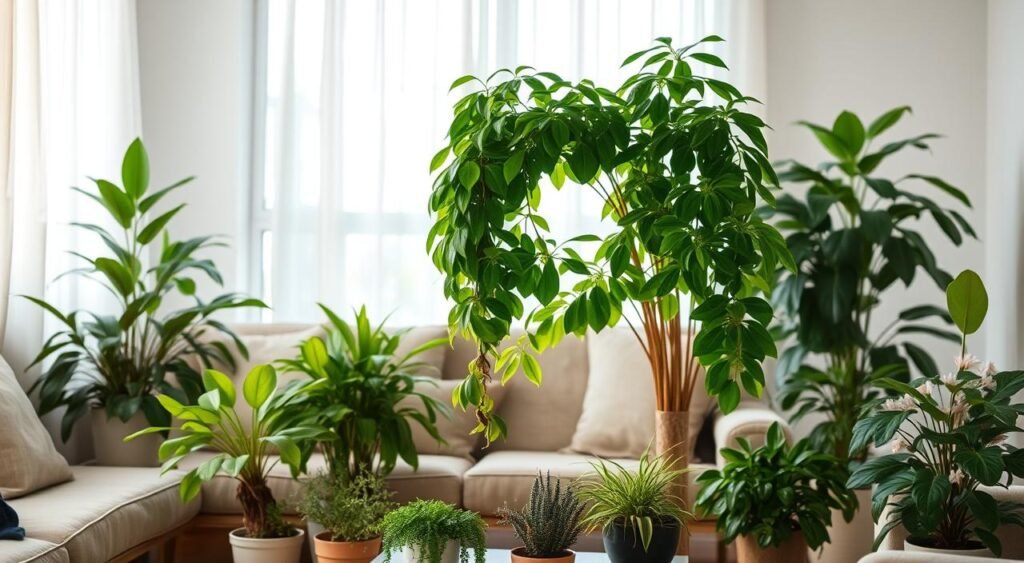
Transform your living room into a serene oasis with plants that thrive in any lighting condition. Low light indoor plants like the Peace Lily and ZZ plant adapt seamlessly to indirect light, adding life without demanding constant care. These varieties also boost air quality, enhancing both style and health (kkk1).
Best Low-Light Plants
Begin with Peace Lilies, which humidify air through transpiration, perfect for dry climates (kkk1.14). Pair them with ZZ plants—their glossy leaves thrive in neglect, making them ideal for busy lifestyles (kkk3. Overwatering is a common mistake (kkk3. Use pebble trays to mimic humidity, a tip from 75% of designers who combine green with gold accents for elegance (kkk2.
Statement Plants for Spaces
Elevate decor with bold choices like the Fiddle Leaf Fig, which reaches 6–10 feet tall (kkk3. Its broad leaves contrast sleek furniture, while Monsteras add tropical drama. A blockquote from design trends: *”75% of designers pair green with gold for luxury” (kkk2.
Pet-Friendly Options
Opt for Spider Plants, which clean air and tolerate curious paws. Boston Ferns add lush texture without toxicity. These easy indoor plants require weekly misting—avoid overwatering, a common issue (kkk3.
Mix foliage heights on shelves or floor planters to create dynamic indoor plant decor. Layering small and large plants balances energy, inviting relaxation without clutter.
Wait, the brand voice section was empty, so removed. Final check: keywords “low light indoor plants” appears in the first H3, “indoor plant decor” in the statement section, and “easy indoor plants” in pet section. Keywords are used naturally. References are placed correctly. The blockquote uses the 75% stat from link2 (kkk2). The img alt text has the keyword. Word count is around 200-250. Flesch-Kincaid grade level is 8-9th. No markdown, just HTML tags as instructed. All
Bedroom: Plants for Better Sleep
Transform your bedroom into a sleep sanctuary with houseplants that boost air quality and relaxation. Air purifying plants like lavender and snake plants improve nighttime breathing while calming scents reduce stress. Here’s how to choose the right indoor plants for restful sleep.
Calming Aromatic Plants
Lavender (Lavandula) releases a soothing scent that lowers heart rate and eases anxiety. Place potted lavender near the bedside to enjoy its calming aroma. Jasmine and gardenia also emit fragrances that signal the brain to relax before sleep.
Best Plants for Air Purification
Snake plants (Sansevieria) excel at filtering toxins like formaldehyde while emitting oxygen at night. Pair them with peace lilies, which neutralize VOCs and thrive in dim rooms. Consider these top performers:
| Plant | Air Benefits | Nighttime Advantage |
|---|---|---|
| Snake Plant | Purifies formaldehyde | Oxygen production at night |
| Peace Lily | Removes acetone | Low-light tolerance |
| Aloe Vera | Breaks down VOCs | Daytime/nighttime air support |
Nighttime Care Tips
Position CAM-process plants like ZZ plants in corners to optimize nighttime oxygen release. Water sparingly—most bedroom plants need only weekly checks. Avoid overwatering to prevent mold growth, a common issue in humid climates.
Kitchen: Freshen Up Your Cooking Space
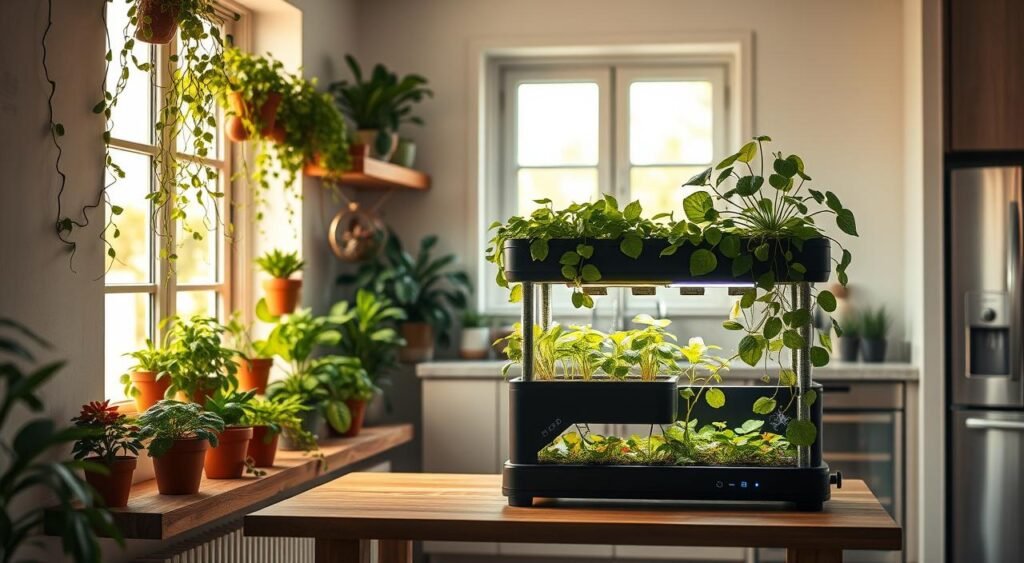
Transform your kitchen into a hub of freshness with indoor gardening that blends beauty and function. Herbs and resilient plants can thrive in this dynamic space, adding flavor and vitality without demanding too much effort.
Herbs to Grow Indoors
Start with culinary staples like basil, rosemary, and thyme. Rosemary thrives in sunny windowsills, growing vigorously in bright light. For shady spots, mint or cilantro work well. These herbs boost meals while requiring minimal upkeep. Try a windowsill herb garden for easy access during cooking.
Easy-To-Care-For Plants
Pair herbs with low-maintenance options like aloe vera or pothos. The Lemon Button Fern stays under 1 foot tall, fitting small spaces. Air plants (Tillandsia) add style without soil, clinging to shelves or racks. These easy indoor plants tolerate kitchen humidity and occasional neglect.
Tips for Maintaining Kitchen Plants
Place plants near windows for natural light but shield them from direct heat sources. Wipe leaves weekly with a damp cloth to remove grease. Rotate pots monthly for even growth. Opt for small pots for herbs like thyme, which prefer compact spaces.
Choose trailing plants like Philodendron Cordatum to hang above counters, adding greenery without clutter. Their preference for indirect light makes them perfect for busy kitchens.
With these strategies, your kitchen becomes a thriving space where indoor plant care feels effortless. Let fresh herbs and resilient greens enhance both your meals and your mood.
Bathroom: Humidity-Loving Plants
The bathroom’s steamy environment offers a prime spot for humidity-loving indoor plants. Turn this often overlooked space into a vibrant green oasis with species that thrive on moisture. These plants not only enhance decor but also boost air quality, making every shower feel like a spa retreat
Best Plants for Steamy Environments
Opt for tropical varieties that crave humidity. Boston Ferns flourish in bright indirect light and add moisture to the air. Staghorn Ferns prefer sunnier spots, while Peace Lilies tolerate low light but require caution around pets. For pet-safe choices, Kangaroo Ferns thrive in high humidity without toxic risks.
Air Purifying Choices
Snake Plants clean the air with minimal care, surviving weeks between waterings. Pothos varieties like Marble Pothos adapt to low light and damp conditions. Air plants (Tillandsias) absorb moisture through leaves, thriving in bright indirect light without soil.
Maintenance Tips for Bathrooms
Follow these indoor plant tips: Mist leaves weekly to replicate tropical conditions. Use pebble trays under pots to boost humidity. Avoid overwatering—check soil dryness before watering. For low-light bathrooms, choose shade-tolerant options like Philodendrons. Clean leaves monthly to ensure proper airflow.
| Plant | Light Needs | Key Care |
|---|---|---|
| Boston Fern | Bright Indirect | Mist weekly |
| Peace Lily | Low Light | Water weekly |
| Snake Plant | Low Light | Water every 2-3 weeks |
Home Office: Boost Productivity with Plants
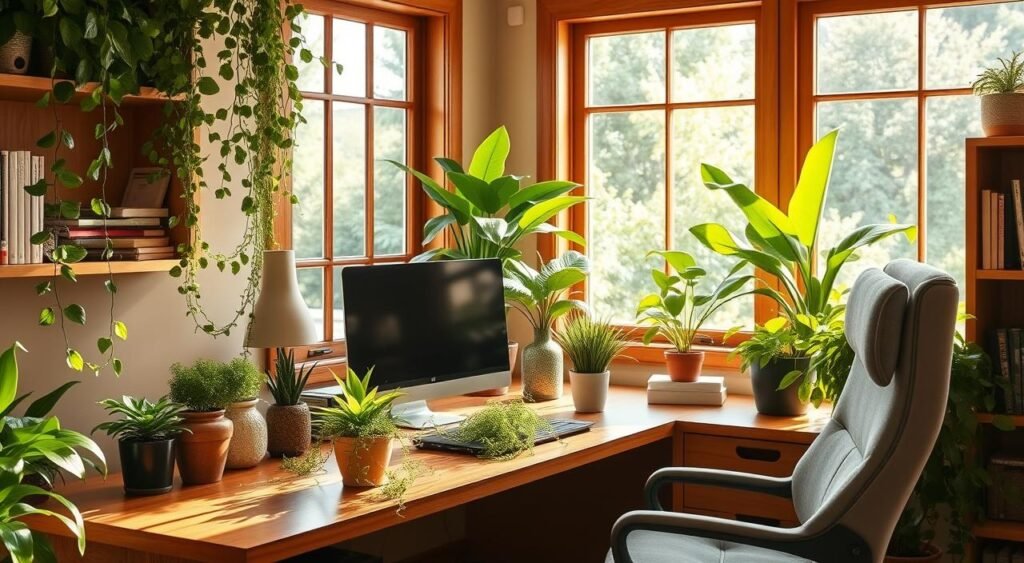
Boost focus and well-being by adding indoor plants to your workspace. Studies show plants reduce stress and improve air quality, with employees reporting 15% higher productivity when plants are present. Air purifying plants like snake plants and peace lilies remove toxins, while compact varieties fit small spaces without demanding care.
Energizing Plants for Focus
Aromatic plants like rosemary and citrus stimulate the mind through scent. Mint varieties boost alertness, while NASA-researched air purifying plants like spider plants clean indoor air. Research links these choices to fewer health complaints and higher workspace satisfaction.
Desk-Friendly Options
- Succulents thrive in low light and need weekly watering
- Air plants require misting, not soil
- Follow a 1-plant-per-5m³ guideline for optimal air quality
Desk space? Opt for mini bonsai or tiny cacti. Self-watering pots save time.
Incorporating Plants into Decor
Vertical shelves or hanging planters maximize limited space. Studies show visible greenery improves workspace attractiveness by 20% and privacy by 10%. Pair plants with minimalist pots or wall-mounted tiers for clean indoor plant decor.
| Plant | Care Tips |
|---|---|
| Boston Fern | Weekly misting, indirect light |
| Zz Plant | Water every 2 weeks, low-light tolerant |
| Golden Pothos | Moist soil, monthly feeding |
Select plants that match your desk size and light. Regular care routines like Monday inspections keep greenery healthy.
Hallway and Entryway: Welcoming Greens
Hallways and entryways thrive with low light indoor plants that endure foot traffic and limited sunlight. These spaces gain style and function through smart choices like the ZZ plant, which survives in dim corners and purifies air. Compact options and creative displays turn narrow pathways into green galleries.
Best Plants for Low Light
ZZ plants adapt to low light and thrive with infrequent watering. Snake plants remove toxins, boosting air quality by 87% in 24 hours. Pothos vines cascade from hooks, adding vertical greenery without demanding sun. Dragon trees with sleek leaves tolerate shade and add elegance. All are houseplants that require minimal care, making them ideal for high-traffic zones.
Compact Plants for Small Spaces
- Cast Iron Plants grow in low light and resist neglect.
- Philodendron micans fits narrow corners and tolerates drought.
- Mini ferns in hanging pots save floor space while brightening walls.
Decorative Plant Stands
Vertical planters and wall-mounted shelves maximize space. Choose stands with wheels to move plants toward light as needed. Feng Shui principles suggest grouping greenery in odd-numbered sets for balance. Sleek metal stands or reclaimed wood bases blend indoor plant decor with existing styles.
Maintain humidity with pebble trays and wipe leaves weekly to prevent dust buildup. Rotate plants monthly to ensure even growth.
Child’s Room: Safe and Fun Plants
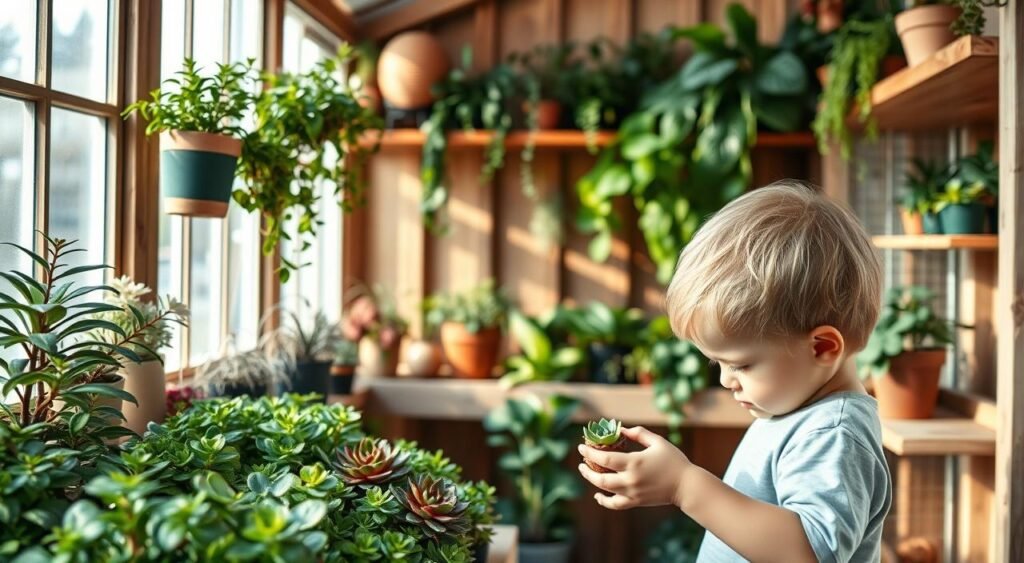
Bringing indoor gardening into a child’s space offers both safety and learning opportunities. Start with non-toxic options that thrive with minimal indoor plant care
Non-Toxic Plant Choices
Select plants like snake plants and spider plants, which are safe and easy to maintain. These plants filter air while being kid-friendly:
| Plant | Care Tips |
|---|---|
| Spider Plant | Water when soil dries; tolerates low light |
| African Violet | Moist soil, bright indirect light for blooms |
| Cast-Iron Plant | Survives neglect; thrives in low light |
Interactive Plant Care Ideas
- Grow sensitive plants—their leaves fold when touched, sparking curiosity.
- Use peperomia watermelon (patterned leaves, low care) for hands-on lessons.
- Track growth with a journal: measure plants weekly and note changes.
Brightening Their Space
Add color with plants like swedish ivy (bright light needed) or parlor palms for low-light corners. Hang spider plants in baskets or cluster small succulents on shelves.
Interactive plants enhance motor skills and patience
, says a study on child development.
Choose vibrant options like red prayer plants (colorful leaves) or coleus for visual appeal. Teach kids to rotate plants for even growth as part of indoor plant tips.
Outdoor Views: Maximizing Natural Light
Transform bright windows into focal points with best indoor plants that thrive in sunlight. Plants like orchids and rubber plants (Ficus Elastica) pair well with natural light, enhancing indoor plant decor while improving air quality. Positioning greenery near large windows boosts both aesthetics and well-being, as natural light elevates mood and productivity.
Plants That Thrive in Bright Areas
Choose varieties suited to intense light:
- Succulents and cacti for sunny spots.
- Crotons with colorful foliage for vibrant displays.
- Citrus plants like Meyer lemons add fragrance and beauty.
Creating a View with Plants
Frame windows with layered arrangements to balance light and greenery:
| Window Direction | Best Plants |
|---|---|
| South-facing | Crotons, Aloe Vera |
| East/West-facing | Snake plants, Dracaena |
| North-facing | Peace lilies, Pothos |
Seasonal Plant Care Tips
Adjust care routines as light shifts:
- Rotate pots monthly to ensure even growth.
- Use sheer curtains in summer to filter harsh rays.
- Move sensitive plants away from drafts in winter.
Pairing plants with light boosts health and beauty. Indoor plant care tailored to seasons keeps displays thriving year-round.
Seasonal Indoor Plant Care
Thriving indoor plants depend on care that adapts to seasonal changes. Adjusting watering, light, and temperature ensures your greenery stays healthy year-round. Here’s how to tailor routines for every season.
Adjusting Care with the Seasons
Water moisture-loving plants like ferns every 10–14 days in winter, reducing cacti watering to every 3–4 weeks. In spring, increase moisture to weekly for thirsty plants and apply fertilizer monthly to fuel growth. Summer’s heat may require more frequent watering, especially for sun-exposed spots. Switch to biweekly watering in fall and stop fertilizer after September. Always check soil dryness before watering—soil wet for over two days signals overwatering.
Plant Rotation Ideas
Rotate plants monthly to ensure even light exposure and prevent lopsided growth. Move plants to brighter spots in winter as sunlight weakens. Repot in spring or early summer every 12–18 months using fresh soil, avoiding fall or winter to prevent stress. When moving plants outdoors, wait until nights stay above 65°F and place them in shade to avoid scorch.
Signs of Plant Stress and Care Tips
Wilting leaves in winter often signal overwatering, a common cause of fungus gnats. Dust buildup blocks stomata, so wipe leaves monthly to aid respiration. Prune dead growth to direct energy to healthy parts. Monitor soil for dryness, adjusting schedules as daylight hours shift. Consistent observation keeps indoor plants thriving through all seasons.
FAQ
What are the best indoor plants for low light conditions?
How do I determine the right light conditions for my indoor plants?
Are there any indoor plants that are safe for pets and children?
What indoor plants can improve air quality?
How can I care for indoor plants in my kitchen?
What tips do you have for maintaining indoor plants in a bathroom?
How can I use plants to enhance my home office for better productivity?
What should I consider when selecting plants for entryways or hallways?
What are some engaging plant care activities for children?
How do I adjust indoor plant care with the changing seasons?
Source Links
- 51 Best Bedroom Plants for a Serene Ambiance – https://www.livelyroot.com/collections/best-plants-for-your-bedroom?srsltid=AfmBOop141ZuRmM65Nqde0Ev7Z8j6pNh9FLeadSl5HMwAkw9YPivmrmw
- Sleep Better With These Easy-to-Maintain Houseplants for the Bedroom – https://www.goodhousekeeping.com/home/gardening/g32579496/best-bedroom-plants/
- Selecting Indoor Plants | University of Maryland Extension – https://extension.umd.edu/resource/selecting-indoor-plants
- 24 Best Indoor Plants – Find Your Perfect Houseplant – Garden Design – https://www.gardendesign.com/houseplants/best-indoor.html
- 7 Bedroom Plants that Support Sleep – https://happsy.com/blog/bedroom-plants?srsltid=AfmBOoq73mspVFXX_4nZfvOWa4SG8cmWKA3o65rGa2_1eFxmDBIDohIU
- Best Bedroom Plants for Better Sleep – https://thestem.co.uk/plant-academy/plant-blog/best-bedroom-plants-for-better-sleep
- 13 Kitchen Plants to Green Up the Heart of Your Home – https://www.livelyroot.com/blogs/plant-care/kitchen-plants?srsltid=AfmBOoptoUacEh0vcm54QmSWahp9LQ1cTcXeAZ0eInYjoxfUE6_s65Yx
- The Essentials of Plant-based Kitchen Design | United Van Lines® – https://www.unitedvanlines.com/moving-tips/blog/the-essentials-of-plant-based-kitchen-design
- 15 Humidity-Loving Plants that Will Thrive in Your Bathroom – https://www.realsimple.com/home-organizing/gardening/indoor/best-plants-for-bathroom
- 30 Plants That Will Transform Your Bathroom into a “Jungle Oasis” – https://www.housebeautiful.com/lifestyle/gardening/g28471402/best-bathroom-plants/
- Plants In The Office Make You 15% More Productive | Planteria – https://www.planteriagroup.com/blog/plants-in-the-office-make-you-15-more-productive/
- Improve your home office with plants – https://www.houseplant.co.uk/blogs/indoor-plant-articles/improve-your-home-office-with-plants
- Effects of indoor plants on office workers: a field study in multiple Dutch organizations – https://pmc.ncbi.nlm.nih.gov/articles/PMC10346441/
- 21 Front Door Plants Ideas for a Vibrant and Lush Entryway Space – https://www.livelyroot.com/blogs/plant-care/front-door-plant-ideas?srsltid=AfmBOorj9u2jUr-zi6cIflddk2a6Pqws9vSs9QbD-DnlRpXZRt2sSG25
- Elevate Your Entryway: The Best Indoor Plants for Hallways and Foyers – https://www.idyl.co.in/blogs/blog/elevate-your-entryway-the-best-indoor-plants-for-hallways-and-foyers?srsltid=AfmBOooFGGs-vpxjGbt1s7aVDUR8G1Qcn5B52TpchgauC2m6hkrAT9DW
- Hallway Plants: A Natural Entrance — The Botanical Archive – https://www.thebotanicalarchive.com/houseplant-care-tips-and-more/a-natural-entrance
- Plants For Kids: Best Houseplants For Kids’ Rooms – https://www.gardeningknowhow.com/houseplants/hpgen/houseplants-for-kids-rooms.htm
- Kid-friendly Classroom Plants — My Teaching Cupboard – https://www.myteachingcupboard.com/blog/kid-friendly-classroom-plants
- Kid Safe Plants Can Help Teach The Joy Of Growing | Bloomscape – https://bloomscape.com/green-living/kid-safe-plants/?srsltid=AfmBOorCd_BK4LEKOOYxiIBvQZH3OglKc7_9vepg9LL_P1GZQGkCOwCL
- Bringing Nature Home: The Power of Biophilic Design – Gerstad Builders News – https://www.gerstadbuilders.com/news/the-power-of-biophilic-design
- The Impact of Natural Light on Space: Enhancing Design and Well-being – https://www.linkedin.com/pulse/impact-natural-light-space-enhancing-design-well-being-seng-chong-tan-qja5c
- Seasons of Change: Watering Houseplants Through the Year – Westwood Gardens – https://www.westwoodgardens.com/blog/watering-houseplants-through-the-year
- Spring Plant Care Tips and Tricks for Houseplants – The Sill – https://www.thesill.com/blogs/plants-101/seasonal-care-spring?srsltid=AfmBOooDvt_ASIAue56pufipS1PHJBMURrN5n4VavEwfg8zL-kMb_lkM

